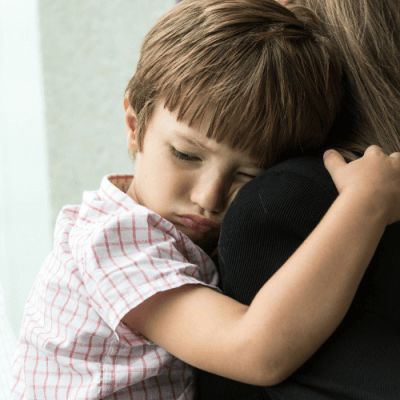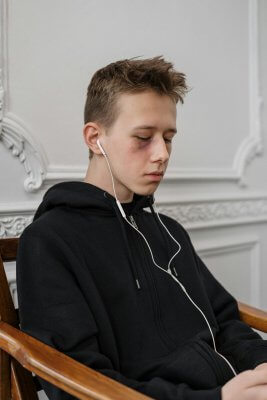Childhood Anxiety: Signs, Causes & How Parents Can Help
Anxiety is a natural and essential human emotion. It helps us stay alert and cautious in uncertain situations. However, when anxiety becomes overwhelming, it can disrupt daily life, especially in children and young people. Understanding the different types of anxiety, its manifestations, and how to support children through it is crucial for parents and caregivers.
What is Anxiety?
Anxiety is often associated with stress or worry, but it encompasses much more. It is one of the core human emotions, affecting thoughts, behaviours, and even physical sensations. Throughout history, psychologists, psychiatrists, and philosophers have tried to define anxiety. Danish philosopher Søren Kierkegaard famously referred to anxiety as “the dizziness of freedom” in 1844, suggesting that having choices and making decisions can create anxiety.
Not all anxiety is bad. Some levels of anxiety can enhance performance and motivation. However, excessive anxiety can be debilitating, leading to avoidance behaviours and panic attacks. The key is understanding what level of anxiety is productive and when it becomes a hindrance.
How Does Anxiety Manifest in Children and Young People?

By: Sherif Salama
Children and teenagers experience anxiety differently from adults. They may not always have the words to express their feelings, so anxiety often presents itself through behaviours, physical symptoms, and emotional distress.
Common Signs of Anxiety in Children and Teenagers:
- Physical Symptoms: Headaches, stomachaches, nausea, and sleep disturbances
- Behavioural Changes: Withdrawal from social activities, school refusal, or irritability
- Emotional Responses: Increased clinginess, avoidance, excessive worry, or aggression
- Cognitive Signs: Difficulty concentrating, excessive fear of failure, or persistent negative thoughts
Anxiety in children is often linked to transitions—starting nursery, moving schools, or dealing with changes in family structure. The uncertainty of these transitions can trigger heightened anxiety responses.
Understanding Panic Attacks and Severe Anxiety
At its most extreme, anxiety can manifest as panic attacks—episodes of intense fear accompanied by rapid heart rate, shortness of breath, dizziness, and a sense of impending doom. These occur when the body’s fight-or-flight response is triggered inappropriately.
Severe anxiety disorders, including phobias and obsessive-compulsive disorder (OCD), often develop as ways to manage overwhelming anxiety. For example, a child with OCD may repeatedly check locked doors to gain a sense of control and safety. While this may temporarily reduce anxiety, it can become a disruptive cycle, requiring professional intervention.
Causes of Anxiety in Children and Young People
 Identifying the root cause of anxiety can be complex, as it varies from child to child. However, research highlights several key contributors:
Identifying the root cause of anxiety can be complex, as it varies from child to child. However, research highlights several key contributors:
- Family Influence: Anxiety can run in families. Children of anxious parents may adopt similar ways of coping with stress.
- Early Trauma and Life Events: Exposure to stressful events, such as parental separation, bullying, or illness, can increase anxiety risk.
- Social and Environmental Factors: School pressures, academic expectations, and peer relationships play a significant role in childhood anxiety.
- Global and Societal Issues: News about climate change, war, and economic uncertainty can increase anxiety levels in young people.
The COVID-19 pandemic significantly impacted children’s mental health, disrupting their routines, social interactions, and sense of security. While some children found comfort in the structured environment of home, others struggled with increased anxiety and uncertainty.
How Parents Can Support Children with Anxiety
When supporting an anxious child, parents can take two main approaches: practical support (parent doing) and emotional support (parent being).
 The Parent Doing: Practical Ways to Help
The Parent Doing: Practical Ways to Help
- Validate Their Feelings: Acknowledge and name your child’s emotions. Saying, “I see that you’re feeling anxious about this,” helps them feel understood.
- Gradual Exposure: If a child is anxious about a new experience, like taking public transport alone, introduce it step by step. Start by accompanying them, then gradually increase their independence.
- Teach Relaxation Techniques: Encourage deep breathing, mindfulness, and exercise to help regulate emotions.
- Maintain Routine and Structure: Predictability helps children feel secure. Consistent mealtimes, bedtimes, and study schedules can reduce anxiety.
- Limit Stimulants: Reduce caffeine and sugar intake in older children to prevent heightened anxiety responses.
- Encourage Expression: Journaling or talking about worries can help children process their emotions.
The Parent Being: Managing Your Own Anxiety
Children learn emotional regulation by observing their parents. If a parent is visibly anxious, their child is more likely to absorb that anxiety. Practicing “emotional containment”—acknowledging and managing your own worries without reacting impulsively—can help children feel more secure.
John Keats’ concept of negative capability—the ability to tolerate uncertainty without immediate action—offers a useful perspective. Parents who can sit with uncertainty and model calm thinking provide a powerful example for their children.
 Supporting Teenagers Through Anxiety
Supporting Teenagers Through Anxiety
Adolescence is a period of major transition, making anxiety particularly common. The pressure of exams, social expectations, and future uncertainties can feel overwhelming. Some teenagers may revert to childlike behaviours, while others push for independence but struggle internally.
Key strategies for supporting teenagers include:
- Open Conversations: Give them space to talk about their worries without immediately offering solutions.
- Encouraging Problem-Solving: Instead of fixing problems for them, guide them to find their own solutions.
- Setting Boundaries: Maintain consistent expectations while allowing autonomy.
When to Seek Professional Help
Mild to moderate anxiety is a normal part of development, but if anxiety significantly interferes with daily life, professional support may be necessary. Consider seeking help if:
- Your child avoids school, social interactions, or everyday activities due to anxiety.
- Physical symptoms (headaches, stomachaches) persist without a medical cause.
- They engage in compulsive behaviours that disrupt normal functioning.
- They have frequent panic attacks or overwhelming fear.
Therapeutic approaches such as Cognitive Behavioural Therapy (CBT) and play therapy can help children develop coping strategies to manage anxiety effectively.
Conclusion
Anxiety in children and young people is increasingly common, but with the right support, they can learn to manage it effectively. By balancing practical support with emotional containment, parents can help their children navigate anxiety with confidence.
If you’re concerned about your child’s anxiety, consider speaking to a professional for tailored support. Acknowledging and addressing anxiety early can make a lasting difference in their emotional wellbeing.
About the Author
Dr Peter Slater is an experienced child psychotherapist based at Harley Therapy, specialising in anxiety, depression, and emotional regulation in children and young people. With extensive experience in supporting families, he takes an integrative approach that combines psychodynamic therapy, CBT, and mindfulness-based interventions to help young people build resilience and navigate life’s challenges.





